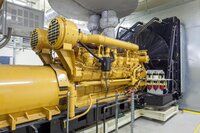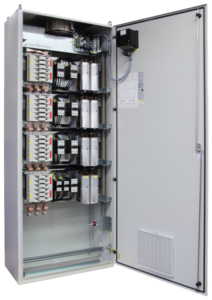Power factor correction for sites with their own generators
Generating one's own electricity onsite, using diesel generators and CHP units, is a viable proposition primarily for those companies that have a great need for process heat. The unavoidable heat from generators operating at efficiencies of about 60%, which would otherwise be considered a waste product, can be put to good use in their production processes.
Another benefit of onsite generation is, of course, that the company needs to draw less power from the public supply network. However, if care is not taken, the electricity bill may still be considerable despite the reduced demand for external energy. This situation is caused by reactive power.
In Germany, electricity suppliers allow companies to draw reactive energy at levels up to 50% of the metered active energy at no charge. There are similar rules in other countries. However, if the onsite generators greatly reduce the active power drawn from the supply network, the reactive power that can be drawn free of charge will be reduced proportionately.
Initial Status

One of the global leaders in the manufacture of self-adhesive products and system solutions produces its continuously needed process heat with the help of its own diesel generators. The power supply to the state-of-the-art production lines is equipped with detuned power factor correction systems and operates without disruption. Despite this, the invoice from the external electricity supplier—based on the company's actual consumption of reactive energy—was too high. An in-depth analysis by FRAKO revealed the reason. The company's own reactive current was causing the transformers at the new substation to generate reactive power that was not measured by the existing power factor correction system and was consequently not compensated for. FRAKO calculated the corrective power still needed and extended the existing correction system to the required level, in addition installing fixed power factor correction capacitors for the transformers.
(iStock.com/jaypeterson)
Creating an additional corrective power buffer at the transformer

The power factor cos (Phi) is the central parameter when reactive power is evaluated, as it represents the ratio of active to reactive power. When cos (Phi) equals 0.7, the reactive power is approximately equal to the active power, but when cos (Phi) equals 0.9, the reactive power is only about half the active power. At this ratio, the consumer is not charged for the reactive power. If a company generates its own electricity, the value of cos (Phi) should approach 1.0 in order to have a sufficient buffer of corrective power at the delivery point or meter.
In practice, this means that almost twice as much corrective capacity is needed to attain this last 10%. This greatly inflates the cost of the power factor correction system. In the case of onsite power generation, however, there is a financial trade-off: reactive power costs versus investment in an extended power factor correction system. The practical solution is to provide additional direct power factor correction for the transformers in the form of fixed capacitance. This is independent of the controlled power factor correction, and can also compensate for the reactive power at the transformer under no-load conditions.
Be on the safe side with an all-inclusive service package from FRAKO.
Even if customers already know that (extended) power factor correction is necessary, it is still advisable to let FRAKO specialists analyse the complete installation. They take a very close look at the existing power factor correction systems, check out the interplay of the various parameters and investigate any resonance or harmonics issues. A distinction is made between fixed capacitor stages at the transformer, controlled power factor correction at the subdistribution board and a central or decentralized power factor correction system at an electric motor.
The decision on how much corrective power is actually necessary always depends on the individual project. Although modern electrical machinery and installations require less reactive power because of their frequency converter drives, there are still some exceptions. Fresh challenges are also faced by those companies that generate their own electricity, even with photovoltaic systems or CHP units. As ever, it is important that no excessive reactive power is present at the interface between the external electricity supplier and the commercial consumer.

